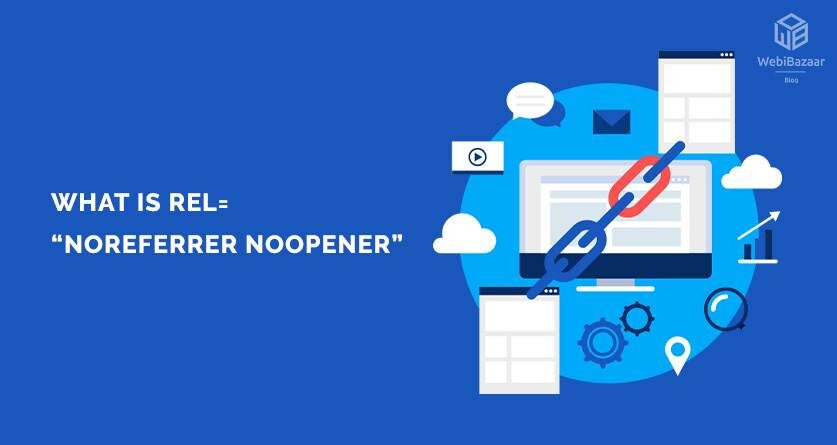“noreferrer noopener”, are HTML attributes that can be attached to outgoing links. What do certain tags do and how they can affect your SEO efforts?
In this post, I will explain the variation of noreferrer noopener tags, how they are different from the nofollow tag, and the impact on SEO when each one is used.
What is rel=“no-referrer”?
The rel=”no-referrer” tag is a specific HTML attribute that can be added to a link tag <a>. It blocks passing the referrer data to the target website by removing the referral info from the HTTP header.
This indicates that in Google Analytics traffic beginning from links that have the rel=”no-referrer” attribute will show as Direct Traffic instead of Referral.
This is how the noreferrer tag looks in HTML View.
<a href=”https://www.example.com” rel=”noreferrer”>Link to Example.com</a>
Here is an Example to Understand this better:
Let’s assume that you link from website A to website B without the “no-referrer” tag.
While the owner of website B views the ‘ACQUISITION’ report in Google Analytics, he can see traffic coming from Website A, under the ‘REFERRALS’ section.
When you link from Website A to B using the “no-referrer” tag, any traffic going from website A to B will show as Direct Traffic in Google Analytics.
When to use rel=”no-referrer”?
Use the rel=”no-referrer” attribute on outgoing links when you do not want other sites to know that you are linking to them. Can not think of any valid reason why you might want to do this, but that is the case.
Clearly do not use the rel=”no-referrer” tag on internal links, it can mess up your Google Analytics reports.
Related: Dofollow VS Nofollow: Which link Affects Your Website?
rel=”no-referrer” and SEO
Combining the no-referrer tag to your links does not immediately affect SEO. You can safely use it without disturbing anything.
But it does have an indirect impact on your link building and promotion efforts and the cause is the following:
One of the ways to get the concentration of other webmasters is to link to their sites. All webmasters control their Google Analytics on a regular basis and particularly the ‘Referral traffic.
When they see traffic from a website, they will most probably check it out and share the page on social media, follow and author or even decide to return the favor by linking back.
This is great for SEO and in fact, it is something that Google supports as a valid way to get links from another website.
When you have the no-referrer tag attached to your links, nothing from the above will happen because traffic from your website will not show as ‘Referrer’ in Google Analytics and so another webmaster will not know that you have linked to them.
The Different Between Nofollow and Noreferrer
When you add rel=”nofollow” to an outer link, you primarily tell search engines not to pass any PageRank from one page to the other. In other words, you say them to ignore that link for SEO purposes.
The contrast between nofollow and no-referrer is that no-referrer does not pass any referral information to the browser but the link is Dofollow. With nofollow, referrer information is passed to the browser but the link is not followed.
So, they are not the same things. Use nofollow on links that you do not trust and use no-referrer. If you do not want the other site to know that you have linked to them.
What is rel=” no opener”?
rel=” no opener” is an HTML attribute that can be attached to external links. It prevents the opening page to get any kind of access to the original page.
Here is the example of a link with the rel=” no opener” tag.
<a href=”https://www.example.com” rel=”noopener”>Link to Example.com</a>
This is attache automatically by WordPress on every external link that opens in a new tab for security purposes and it is recommend that you keep it.
If you aren’t on WordPress, it is advise to add the rel=” no opener” to all your external links that open in a new tab.
rel=” no opener” and SEO
It has zero impact on your SEO so you can safely use it to enhance the security of your WordPress website.
Key Learnings
Dealing with HTML tags is confusing for several people. But that should not be the case with noreferrer noopener.
None of them can negatively affect your SEO, use them without fear.
If you are on WordPress Templates, these tags are add automatically on external links that open on a new web.
The no opener is need to enhance the security of your website and prevent another website from gaining access to your page.
The no-referrer is use to protect referrer information from being pass to the target website and also hides referrer traffic in Google Analytics.
If you want another website to see traffic from your website as ‘Referrer traffic’. Then simply don’t open external links in a new tab. This will check WordPress by automatically adding the attributes to the links and everything is great.
Nofollow is not the same as no-referrer but when the rel=”nofollow” is add to a link. It instructs search engines not to use that link for SEO purposes. Noreferrer dose pass link juice from one website to another.
If you are still confuse about rel= “noreferrer noopener”, let me know in the comments.
